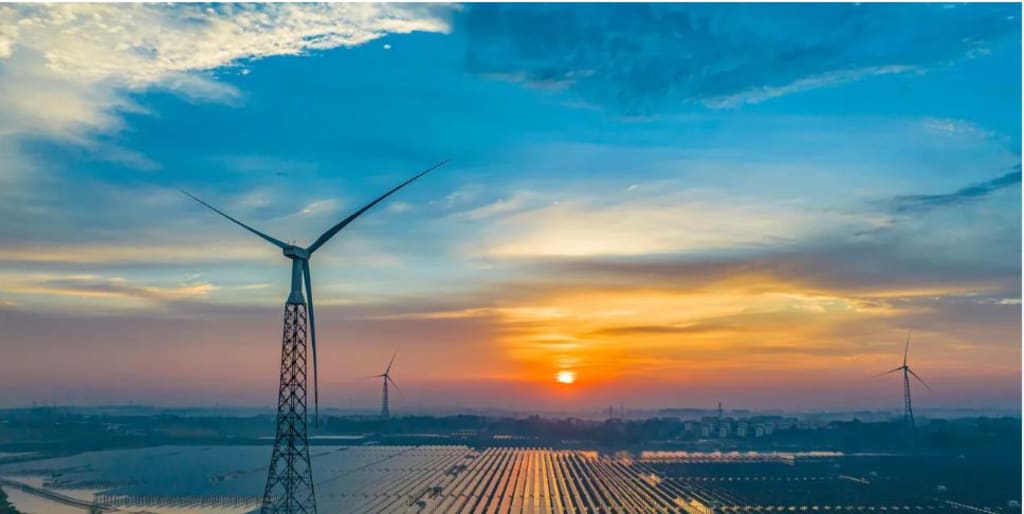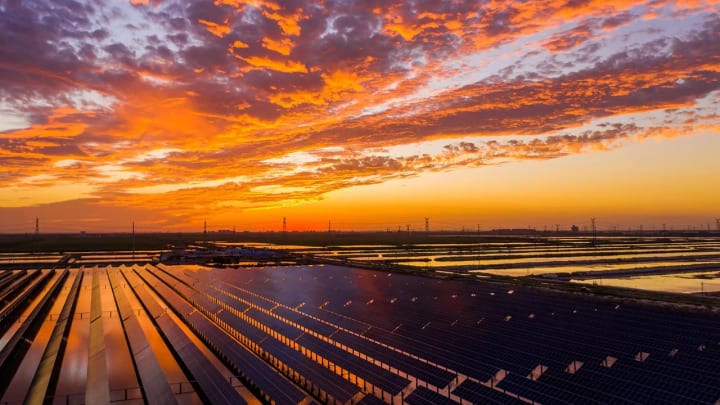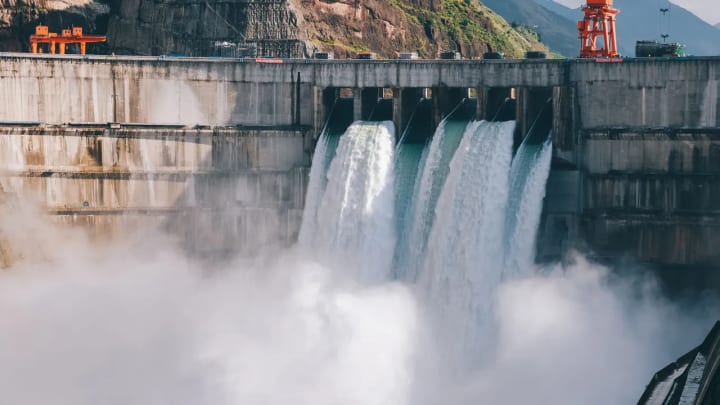How limitless green energy would change the world
Limitless renewable energy would offer tantalising benefits: emissions-free heating, greener fertiliser and electric transport. But overcoming the obstacles will not be easy.

What would we do with an abundant, cheap, inexhaustible supply of renewables?
Perhaps the desalination of seawater, suddenly cost-efficient, would relieve Earth's water shortages. Rubbish might be recycled on a massive scale, allowing for the extraction of precious trace elements such as rare earth metals, while carbon dioxide (CO2) could be vacuumed out of the atmosphere to slow climate change. People could live comfortably in Earth's polar regions or travel far and wide in battery-powered vehicles. Goods and services that require electricity might become cheaper, even free. Our emissions footprint could soon be undetectable.
While exciting to contemplate, this sustainable world would be incredibly costly. It would also hinge on a wide range of political, economic and technological factors to ever make it a reality.
Green energy may be limitless, but certainly not limitless without cost – Victor B Flatt
Green energy's success depends on people's willingness to adopt the technology in the first place – renewable alternatives would have to promise more convenience, speed, savings and security than the oil, coal and gas on which we've grown so reliant. Lawmakers would also need to combat legislative gridlock to ensure that sustainable energy policies could be implemented. The facilities that combust this green energy – be it solar, wind, geothermal, biomass, or even nuclear fusion or some undiscovered technology – would need to be built and maintained as the planet continued to warm and resources dwindle.
And assuming these obstacles could be overcome, how could limitless green energy change our own consumption, innovation, our economy, public policy and the environment? And what factors might make this hypothetical planet temporarily worse off?
According to the International Energy Agency (IEA), electricity demand is set to grow by 40-60% in some regions in the next 10 years. Researchers predict that mounting prosperity in both the developed and the developing world will continue to drive increased consumer demand for key resources up to at least 2040. At the same time, constraints in energy, water and other natural resources will bring about new and difficult-to-manage instabilities.
Current electricity generation – primarily by fossil fuels – is the single biggest contributor to climate change, responsible for 30% of all greenhouse gas emissions. Green energy could thus represent a radical deviation from business-as-usual, promising a path towards zero-carbon emissions and international energy independence. Without the concerted efforts of policymakers, investors and citizens, however, limitless green energy could also lead to a world of increased waste and shortages.
"Green energy may be limitless, but certainly not limitless without cost," says Victor B Flatt, professor of environmental law and head of the Environment, Energy and Natural Resources Legal Center at the University of Houston. From the enormous capital outlay required to build renewable power plants – or convert existing ones – to the marketing investments needed to incentivise its use to the emissions-emitting extraction processes needed for new infrastructure, free green energy comes at a high price.

There are no perfect answers. What will be required in the years ahead is a diverse and flexible mix of energy solutions – what Bill Gates calls a "Swiss army knife of energy tools."
Carbon-free energy certainly promises tantalising benefits: total electrification of transport, emissions-free heating and cooling systems to power our homes and businesses, greener fertiliser for our farmlands. If we can manage to produce it, we might also need to use supplementary sources of fusion power. Developing efficient and sustainable methods of burning biomass, and converting methane from crops and sewage, would help to increase our green fuel supply, but we would also need to reduce our total energy and explore ways to turn climate policy into concrete, enforceable action.
As parts of the world begin to wean off fossil fuels, our current fuel supply would become cheaper and cheaper, says Flatt. Oil-rich countries, eager to sell their last barrels to developing nations, would drive the price down further, slowly eliminating liquid-fuel economies. "If green energy is more competitive than fossil fuels, people will move in that direction," says Flatt. "But real-world constraints will start to take over."
You might also like:
What would happen if we stopped using plastic?
India's sustainable cooling solution
The batteries powered by gravity
Traditional power plants will play a smaller role as decarbonisation objectives and national mandates require their reduced use. Simultaneously, a robust infrastructure of variable renewables plants will become absolutely crucial. These plants will need to be built over a large geographical area in order to ensure minimal power interruption – if it's a grey, windless day in Dublin, electricity might need to be channeled from as far away as Oslo, for example. This boom in manufacturing will likely lead to stable, long-term job creation – a net positive – but could also mean temporary job losses in other sectors, such as coal.
Another formidable constraint is that green energy is notoriously unreliable. Hydropower requires enough rain to propel a constant supply of flowing water and can wreak havoc on native aquatic species and their ecosystems. Solar photovoltaic panels need clear skies and sunshine to harness photons of light required to generate electricity.
Variable renewables are power generators that depend on the availability of intermittent resources; they therefore require complementary technologies to ensure that the balance between supply and demand is maintained at all times – even during seasonal changes or worst-case scenarios. Limitless green energy would almost certainly give rise to innovative methods to use and store energy cheaply and efficiently, but creating a permanent surplus of power may not be economical at scale.

"There will be times when we will have more energy than we actually need in particular places," says Richard Green, professor of sustainable energy business at Imperial College Business School in London. "Finding ways to use that extra energy at those times is a great idea, but not predictable enough for people to plan their lives around." As such, traditional modes of power could still be needed in limited supply, so that if we are short of green electricity there's a stopgap measure.
Increasing shares of variable renewable energy mean that power systems will likely become more flexible. Of course, demand needs to be flexible as well. "Either people are paying a subscription – a bit like a phone plan where you get free energy up to a certain amount," explains Green, "or it's a pay-as-you go model." Uber's surge pricing might look comparatively generous. "The price would have to go through the roof part of the year, whenever there is a shortage of wind or sunlight."
The question of green energy demand won't be limited to households, of course, but would extend to businesses and corporations, particularly tech companies – some of the biggest consumers of electricity. Data centres at leading tech giants such as Amazon, Google, Facebook and Microsoft already require dozens of terawatt hours (a unit equal to one billion kilo-watt hours of electricity) a year to keep their servers cool. As the rise of artificial intelligence and machine learning exacts more computing power, that figure will only increase. Private investments could further accelerate new technologies and change the economics for large companies to deploy them.
If corporations make the switch to carbon-neutral energy, however, they will also put indirect pressure on land already scarce from competing uses, urbanisation and industrial development, because more renewables plants will need to be built to satisfy demand. This, in turn, will put added stress on the planet: many renewable energy forms or their manufacturing processes emit greenhouse gases such as CO2 or methane into the air, because they rely on minerals (cobalt, lithium, and other rare-earth metals) that can currently only be extracted or built with the aid of fossil fuels. Extraction also has significant potential to irreparably destroy native animal and plant life habitats.
In other words, limitless green energy could actually be harmful to the environment in the short-term. Yet renewables ultimately have the power to reduce or reverse our carbon output and eliminate millions of deaths caused by pollution each year, making the decision to switch one of the most pressing issues of our time.

Fusion power, which generates electricity by using heat from nuclear fusion reactions, is one green technology with incredible promise. This energy format would enable power sources we could turn on and off at will, and eliminate the spent fuel and proliferation concerns of nuclear fission. "Fusion is one pathway to clean forms of energy," says Joshua D Rhodes, a systems-level energy engineer at the University of Texas at Austin. "But thus far, no one has been able to create a fusion reaction that is self-sustaining" (one that produces an energy reaction which generates more energy than it consumes).
If cost is no longer a factor, unlimited green energy in the form of fusion might radically transform different sectors, including transportation, aviation, and manufacturing. The switch would also go a long way towards reducing carbon emissions and overall particulate matter. If we clean up supply chains, we might be able to move away from or eliminate energy sources that emit pollutants into the atmosphere.
Clean energy is necessary, but not sufficient, to meet the 1.5C goal – Joshua D Rhodes
"There are always going to be industries that will need a fossil-fuel like substance," says Rhodes, "but we don't have to dig them out of the ground: we can make a synthetic fuel." For operations that require a lot of energy in a confined space, liquid fuels with carbon in their makeup can be useful, because they keep systems stable. Long-haul flights, for example, currently need a fossil-fuel like substance. Rather than jet fuel, however, aircraft could run on methane derived from hydrogen and CO2, or ammonia made from hydrogen and atmospheric nitrogen, both of which could be created using green electricity. Given the sector's climate contribution – aviation is responsible for 2.5% of annual CO2 emissions – this change alone would be momentous.
Other green technologies such as carbon capture and storage will likely be necessary to achieve overall net zero emissions. According to the Intergovernmental Panel on Climate Change (IPCC), "Electrification, hydrogen, bio-based feedstocks and substitution, and, in several cases, carbon dioxide capture, utilisation and storage (CCUS), would lead to the deep emissions reductions required in energy-intensive industries to limit warming to 1.5C."
But the IPCC also notes that those options are limited by institutional, economic and technical constraints – meaning a huge fiscal policy push from government would becrucial. "To keep the global temperature rise to below 1.5C, the world needs to get to net-zero carbon emissions between 2050 and 2070," says Rhodes. "Clean energy is necessary, but not sufficient, to meet that goal."

Nations like Costa Rica and Norway have already met many of their ambitious climate targets; other countries lag far behind the 2050 net zero goals needed to keep global warming below the critical 1.5C threshold, set out in the 2015 Paris Agreement. Even in a world of limitless renewables, stabilising the global energy sector will remain out of reach unless individual countries can agree on comprehensive climate change legislation – and do so quickly. Tax credits for the purchase of low-emission cars and appliances, support for the construction of renewable fuel stations and other infrastructure and financial penalties for fossil fuel use could all accelerate the switch.
"The biggest barrier to green energy is not money or even technology; it's government policy," says Flatt. Energy policies can vary even within one nation's jurisdictions, meaning that progress is often slow. Consider that localities must agree to offshore and onshore renewables power sites before green energy demand increases. "Europe has already agreed to derive 20% of its power from offshore wind," says Flatt. "In the United States, however, with its multiple jurisdictions, any state can veto a power line. Getting lawmakers to agree on where power supplies – hydro dams and windmill farms – will be built is essential if we're to fully embrace a green economy."
Not everyone would have immediate access to green energy even if it were suddenly abundant, while those who do might waste it
Finally, a never-ending supply of renewables would not necessarily solve the world's equity problems in the short term. In some places, the ready availability of lighting, heating, refrigeration and transport is a luxury few can afford. Not everyone would have immediate access to green energy even if it were suddenly abundant, while those who do have access might waste it.
"When any commodity gets cheaper, there's a tendency for people to use more," says Green. Likewise, limitless green energy could lead to similarly poor design choices that would spur waste or even shortages during times of scarcity, even as parts of the world continue to do without. "Humans finding ways of dealing with shortages is what has typically driven progress," says Green.The issue is less about overconsumption, which tends to describe exhaustion of a resource, than growth of consumption because the resource is abundant in the first place. There would be enough of the resource available overall, but this abundance may lead to new problems. This phenomenon has historically characterised other resource cost decreases: when we made food cheap and abundant by learning how to process and manufacture it at scale, we developed an obesity crisis. When we devised ways to produce cheap plastic, the oceans were suddenly choked with our single-use bags and bottles. Could a similar pattern emerge if we make green energy abundantly cheap?
Switching to renewable power worldwide could alleviate our climate change crisis, bringing about new forms of innovation and commerce in the process. That might free up time and labour to devote to leisure and other pursuits. But we need to remain realistic. "This solves some problems," says Flatt, "but it's not a Nirvana."






Comments
There are no comments for this story
Be the first to respond and start the conversation.